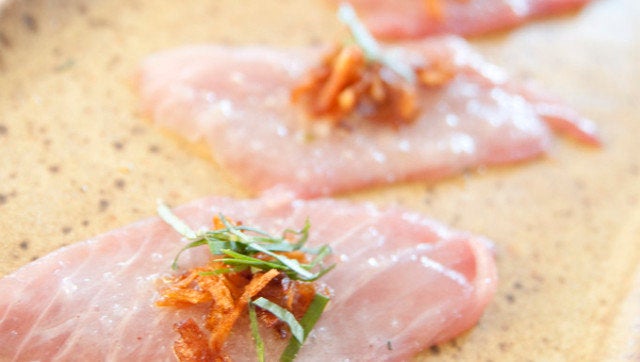
by Kim Thompson, Sustainable Seafood Expert for the Menuism Seafood Blog, and Betsey Suttle
With the recent $1.76 million sale of a single bluefin tuna in Tokyo, bluefin tuna - the poster child for sustainable seafood - is front page news again. These apex predators fetch such high prices because their populations are too low to support the demand, primarily fueled by the sushi market.
What's Going On With Bluefin Tuna?
Question: If the situation is so bad, why don't we stop fishing bluefin tuna altogether?
Short answer: Money. These fish are extremely economically valuable.
Question: Then why not put strict limits on bluefin tuna fishing operations?
Short answer: The management of bluefin tuna is complicated. These fish are highly migratory and travel thousands of miles, crossing oceans and international borders. They are fished and regulated by many nations who don't always see eye to eye on how to best regulate the species.
In this case, the sustainable seafood recommendation is not to choose bluefin tuna.
You Can Still Enjoy Great Sashimi!
Since bluefin tuna is off the menu for conscientious seafood consumers, we asked some local chefs for recommendations for tasty alternatives. Chef Pete Lehmar of Gladstone's Long Beach recommends U.S. Pacific yellowfin, also known as ahi.* "It has a very clean, non-gamey flavor," Lehmar said. "The meat is bright red when raw and is perfect for sashimi, as well as in salads and sandwiches. Yellowfin is also fantastic blackened, making it an excellent choice for Cajun cuisine."
Albacore tuna is another of Lehmar's favorites. "Albacore, also known as Tomba, is a little less sweet than yellowfin. It is a softer tuna, which means that it is a bit more difficult to slice for sashimi. Try it with your favorite marinade in sandwiches and salads."
Chef Michael Poompan, from SIP Lounge at the Renaissance Hotel in Long Beach, is also a fan of albacore tuna, specifically from the U.S. west coast. He especially likes fish that come from farther north where the fish build up a bit of fat. "This extra fat gives a rich smooth texture," says Poompan. He recommends albacore raw with white soy and scallions, or cooked with a light brushing of yakitori sauce.
Poompan also recommends Hawaiian opah and ono. "We did an ono sashimi at the Aquarium of the Pacific's SeaFare event which people loved. We had a ghost chili vinaigrette (garlic and chilies ground in a mortar and pestle, soy sauce, fish sauce, water, sugar, and lime juice), topped with crispy shredded beef, cilantro, and mint."
U.S. west coast Pacific albacore is the most responsible seafood choice presented by the chefs. These fisheries are well-managed and Marine Stewardship Council (MSC) certified. Because they are primarily poll-and-line or troll caught, U.S. west coast albacore tend to be smaller and lower in mercury than their counterparts from other albacore fisheries.
California yellowtail is another well-managed species with a clean and mild flavor, which coupled with its high oil content, makes it an excellent responsible substitute for bluefin tuna.
For all tuna recommendations:
• Be sure to select tuna from a well-managed U.S., poll-and-line, or MSC certified fishery.
• Never overcook tuna. The high fat content that makes it so delicious can produce a fishy taste and smell when overcooked.
You don't have to give up great taste to make responsible choices. Next time you are in the mood for some responsible sashimi, try some of the recommendations from these innovative chefs. They really know their seafood!
*Bigeye tuna is also known as ahi.
Related Links from the Menuism Seafood Blog:
• Chowdahs Call for the Best Bivalves
• Meet the California Spiny Lobster
• Forget Sea Bass. It's All About Sablefish.
• It's Florida Stone Crab Season
Kim Thompson is the program manager for the Seafood for the Future (SFF) program at the Aquarium of the Pacific in Long Beach, California. SFF is a nonprofit seafood advisory program dedicated to promoting healthy and responsible seafood choices in Southern California. The program works with restaurants, fishermen, seafood purveyors, government agencies and other nonprofit groups to execute its mission. Visit SeafoodForTheFuture.org to learn more about SFF partners and recommendations.
 Bluefin Tuna. Photo by InvernoDreaming
Bluefin Tuna. Photo by InvernoDreaming